“Difficult, but important”
Reflection is an important yet ethereal skill that all Occupational Therapists need to master.
Part of completing a reflection is an inner sense of discomfort (in fact the first stage of reflection as described by Boyd & Fales 1983) so it’s no wonder many people put it off and may even try to get by without it, perhaps carrying out token reflections just to comply with CPD or course requirements. To begin with, reflecting on your actions is something that requires conscious effort after the event but eventually, according to Johns (2000), it will become an automatic thought process even when you’re in the middle of experiencing the event. When deciding which model to use, it can helpful to find out what learning style you are according to Honey & Mumford. You can relate these to the knowledge types shown in Carper/Johns’ reflective models.
Below is a rough guide to the different models of reflection out there, and which situations they’re best geared towards. They are ordered (in my opinion) from the easier ones for the beginner who is trying to break down and evaluate a situation, to the more complex ones that build on the basics and hope to elicit a change in your personal beliefs and challenge your assumptions. Gillie Bolton suggests exercises for creative ways to reflect in her book Reflective Practice: Writing and Professional Development (chapter 4).

Like Inception, you’ll naturally find yourself going deeper with your analysis of an event the more experience you gain with reflective models. Enjoy the ride!
+++++++++
Gibbs reflective cycle (1988)
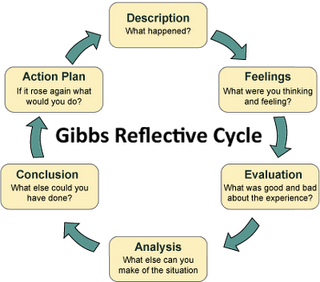
Good for: Good old Gibbs. Basic, good starting point, six distinctive stages. Makes you aware of all the stages you go through when experiencing an event.
Criticisms are: superficial reflection- no referral to critical thinking/analysis/assumptions or viewing it from a different perspective (Atkins & Murphy 1993). Does not have the number or depth of probing questions as other models.
+++++++++++++
Kolb reflective cycle (1984)
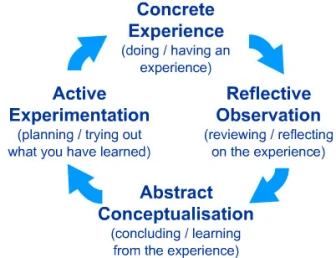
Good for: Basic starter? The reflective cycle. Consists of doing, asking how/why, making judgement,testing out, .
Criticisms are: superficial reflection- no referral to critical thinking/analysis/assumptions or viewing it from a different perspective (Atkins & Murphy 1993). Does not have the number or depth of probing questions as other models.
+++++++++++
Schön model (1991)
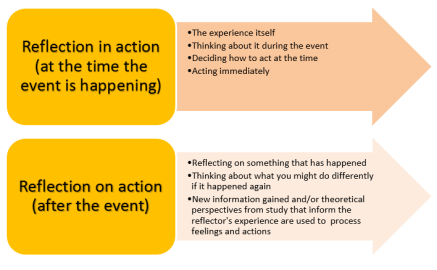
Good for: Schön described reflection-in-action (in the moment surprise & puzzlement) and reflection-on-action (a cognitive post-mortem after the fact). Professional model: gaining professional artistry and increasing professional confidence.
Criticisms are: highlights the difference between the two types of reflection but does not provide extensive guidance for carrying out either.
++++++++++++
Driscoll model (1994)
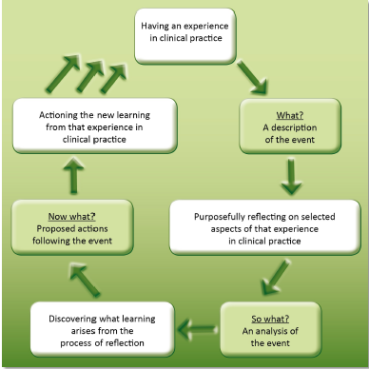
Good for: Organisational model. Easy to follow cued questions. Easy to remember when you’re out and about using the simple “What? So what? Now what?”
Criticisms are: It does not lead to deeper reflection about yourself, only the situation.
++++++++++++
Rolfe et al’s Framework for Reflexive Learning (2001)
Good for: based on the three “What? So what? Now what?” questions, but repeats these questions at three levels, with increasingly deeper reflection at each level. The levels are descriptive, theoretical and action-orientated. This model is based on Borton’s developmental model. Working through the same questions at different levels can be used to develop from novice to expert.
Criticisms are: May be too complicated for a beginner who is new to reflection.
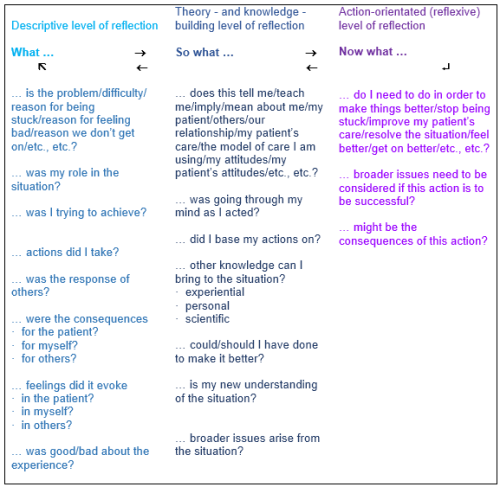
+++++++++++++
Johns’ Model for Structured Reflection (2006)

Good for: Organisational model, examines situations in context of the environment. Provides prompt questions that are easy to follow, and can be used in any order (although they follow a natural progression). Can be used by individuals or groups. Based on Carper’s (1978) four types of knowing -empirical, personal, ethical and aesthetic- Johns adds a fifth one – reflexivity- to create his model.
Criticisms are: The prompt questions aren’t rigidly structured which could be confusing for someone inexperienced to know which ones could be omitted and which are salient for their particular reflection. The amount of questions means it could be time consuming.
+++++++++++
Atkins & Murphy model [1993]
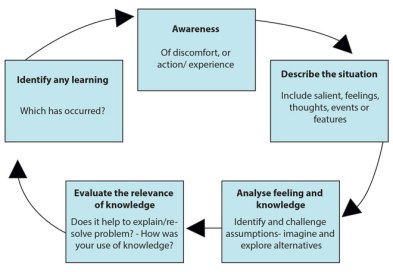
Good for: Deeper reflections, building on your previous experience. It encourages you to consider assumptions
Criticisms are: It may not be suitable for quick reflections on-the-go or for beginners.
+++++++++++++
Brookfield model (2005)

Good for: Personal development model. Analysing a situation from different perspectives- looks at an event through four lenses- self, students (or patients), colleagues, & research. Deeper reflection leading to personal development, takes into account personal self-reflection, patient feedback, peer assessment, and information gleaned from academic literature. Suitable when person is motivated for self directed learning.
Criticisms are: covers four different view points so not the most suitable if you wan to look at an area in depth from one angle.
+++++++++++
Mezirow model of transformative learning [1981]
Good for: First developed in 1981 although has been revised with increasing complexity up until 1997-ish. Personal development model. Involves critically evaluating your assumptions and deep reflection. Frames of reference, from different viewpoints. Reflection on content is shallow, but progresses to reflection on process and reflection on premise which leads to deeper reflection, leading to personal development. Suitable when person is motivated for self directed learning. Mezirow states reflection is only helpful if it leads to a transformation in self or learning from a dilemma.
Criticisms are: This model would only be suitable if someone had the self motivation and time to integrate the learnings from using this model into their own behaviour and schemas, so is a long term model in this sense. Focuses heavily on rational and not emotional aspects
+++++++++++++++++++++++++++++
Sources:
Atkins, S and Murphy, K (1993) Reflective practice. Nursing Standard 9 (45): 31–7.
Boyd E & Fales A (1983) Reflective Learning: Key to Learning from Experience. Journal of Humanistic Psychology 23(2): 99-117
Brookfield, S. (2005) Becoming a Critically Reflective Teacher. San Francisco: Jossey Bass.
Centre for the Advancement of Interprofessional Education
Gibbs G (1988) Learning by Doing: A guide to teaching and learning methods. London: FEU
Johns, C. (2000). Becoming a Reflective Practitioner. Oxford; Blackwell
Johns C (1995) Framing learning through reflection within Carper’s fundamental ways of knowing in nursing. Journal of Advanced Nursing. 22: 226-34
Journal of Interprofessional Care
Kolb, D. (1984) Experiential Learning. New Jersey
Mezirow J (1981) A Critical Theory of Adult Learning and Education. Adult Education Quarterly 32(1): 3-24
Mezirow J (2006) An overview of transformative learning. In P. Sutherland & J. Crowther (Editors) Lifelong learning: Concepts and context.. New York: Routledge
Rolfe, G., Freshwater, D., Jasper, M. (2001) Critical reflection in nursing and the helping professions: a user’s guide. Basingstoke: Palgrave Macmillan.
Schon, D. (1983) The Reflective Practitioner. London: Temple Smith
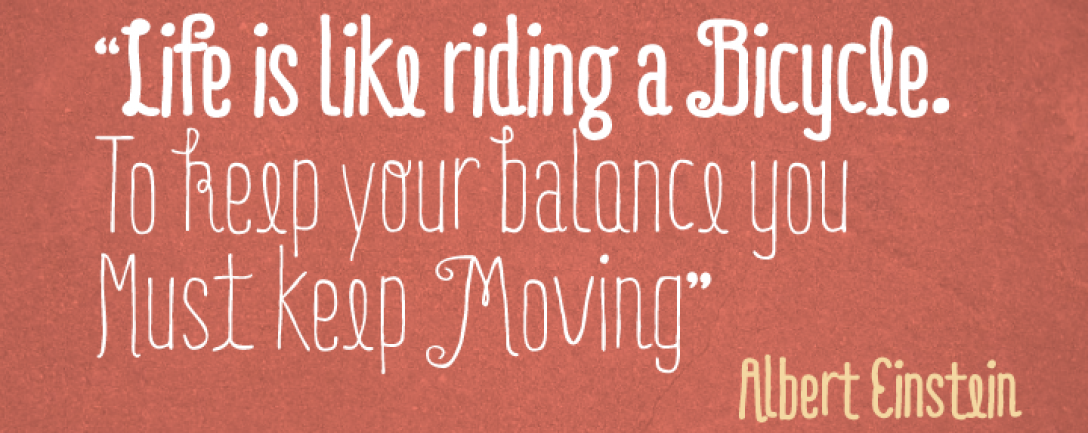
17 thoughts on “Guide to models of reflection – when & why should you use different ones?”
Comments are closed.